Recent awards add to UH’s Humboldt tally
July 19th, 2010 | by Malamalama Staff | Published in Research News | 2 Comments
Germany’s Humboldt Foundation grants up to 100 Humboldt Research Awards annually. Two University of Hawaiʻi at Mānoa scientists have received the award in as many years.
Jeffrey Kuhn, associate director of the Institute for Astronomy responsible for Haleakalā Observatories, is the first U.S. solar scientist to receive the prize. Kuhn and his boss, 2009 Humboldt awardee and IfA Director Rolf-Peter Kudritzki, are among at least 11 UH faculty members who have been recognized by the Humboldt Foundation.
Like the privately established Nobel Prize and the government-sponsored Japan Prize, the Humboldt Award recognizes researchers in a variety of fields and from a variety of countries for achievements that have had significant impact on their disciplines.
The Humboldt Foundation also considers nominees’ potential to continue producing cutting-edge achievements, sponsoring winners to collaborate for up to a year with colleagues at German research institutions.
Namesake and role model
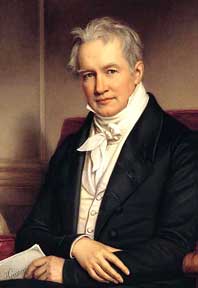
Alexander von Humboldt
Widely considered one of the founders of modern geometry and described as the last universal scholar of natural sciences, Alexander von Humboldt, hiked Europe with Captain James Cook’s scientific illustrator. He mapped 1,700 miles of the Orinco River and climbed 18,000 feet up Mt. Chimborazo in South America, producing 30 volumes about the flora, fauna and topography of Latin America. He was a friend of Thomas Jefferson and advisor to a Prussian king and Russian czar.
Humboldt discovered the Peruvian Current off the west coast of South America, recorded and reported on magnetic declination, developed the first isotherm map and posited the principle of continentality—that the interiors of continents have more extreme climates due to a lack of moderating influence from the ocean.
In 1845, he published the first volume of Kosmos, his project to record everything known about the earth, including humans’ efforts to describe the earth and their interaction with it. The final volume was published in 1862, three years after his death.
The same year, the Alexander von Humboldt Foundation for Nature Research and Travel was established to continue Humboldt’s practice of supporting young scientists. It fell victim to the hyperinflation of 1923, and a second foundation, to World War II. Today’s Alexander von Humboldt Foundation was established by the Federal Republic of Germany in 1953 at the behest of former Humboldt guest researchers.
Humboldt Award recipients not only gain recognition and support to advance their own research, but are encouraged to remain active within the Humboldt organization and extend support to young scholars as well.
“Rising star” is an apt metaphor as four of UH’s Humboldt honorees are in astronomy. Here’s a quick look at UH recipients.
- Jeffrey Kuhn, stellar physics, 2010
- Rolf-Peter Kudritzki, astronomy, 2010
- J. Patrick Henry, cosmology, 2003
- Richard Manshardt, horticulture, 2002
- David Sanders, astrophysics, 2000
- Pavel Zinin, 1993, 2006
- John M. Pezzuto, biochemistry, 1990
- Maqsudul Alam, microbiology, 1986
- Wai Fah Chen, civil engineering, 1984
- Ronald Knapp, mechanical engineering, 1981
- M. E. “Jeff” Bitterman, psychology, 1981
Jeffrey Kuhn, stellar physics, 2010
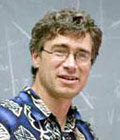
Kuhn
Kuhn uses observations of the sun’s surface made by instruments on the ground and in space to understand the solar interior.
Kuhn helped build a unique telescope that mapped the magnetic field in the sun’s outer atmosphere for the first time. Recently his group found that, unlike almost everything else that we measure about the sun, its diameter is constant to better than a few parts in a million.
During an 11-year cycle, magnetic energy is converted and released into space as solar “wind,” which can create beautiful auroras and disrupt electronic signals on Earth. “Understanding the physics of the cycle may help predict changes in Earth’s climate,” Kuhn says.
He plans to use the Humboldt award to develop new models of how and why the solar cycle is so dependent on the death cycle of sunspots. Deciphering solar physics is critical to understanding how all stars evolve and change, he says.
Kuhn received the Shenstone Prize during his doctoral studies at Princeton. He received an Alfred P. Sloan Fellowship in 1986 and was a Phillips Distinguished Lecturer at Haverford in 1994.
Rolf-Peter Kudritzki, astronomy, 2010

Kudritzki
Stepping down as IfA director at the end of 2010, Kudritzki will use his Humboldt award during a 2011 sabbatical in Germany to investigate the physics of galaxies.
Using the brightest stars in the universe as tools to dissect galaxies, he will analyze spectra of hundreds of supergiant stars (stars with radii as large as 300 times the sun and a hundred thousand times brighter) in distant galaxies.
Applying new methods developed with his collaborators, including Mānoa astronomers Fabio Bresolin and Miguel Urbaneja, he will use the spectra to determine the chemical compositions of galaxies and their distances from us.
Providing accurate numbers for the first time, the data can be used to test the present theory about how galaxies have formed in an expanding universe dominated by cold dark matter and dark energy.
“This project is entirely new. Nobody has ever done anything like this,” Kudritzki says. “I look forward to spending all my energy and time on it.”
J. Patrick Henry, cosmology, 2003
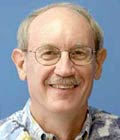
Henry
A professor of physics and astronomy and an astronomer at the Institute for Astronomy, Henry is known for his studies of the evolution of the universe as a whole.
As a Humboldt awardee, he spent four months with collaborators at the Max-Planck-Institut fër Extraterrestrische Physik in Garching, Germany, analyzing data from NASA’s Chandra X-ray Observatory and the European Space Agency’s XMM-Newton X-ray Observatory.
“For most of human history we have wondered where the starry heavens came from and what will eventually happen to them. The scientific study of these questions is termed cosmology. Astronomy has entered what many think will be the golden age of cosmology because for the first time we can gather hard evidence that may lead to answers,” he said at the time.
He is a member of the International Science Working Group planning the use of the Japanese Space Agency’s ASTRO-E2 satellite launched in 2005.
Richard Manshardt, horticulture, 2002
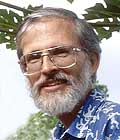
Manshardt
Helping develop a ringspot virus-resistant papaya that saved the Hawaiian papaya industry, earned Humboldt recognition for Manshardt and his team, which included UH alumni Dennis Gonsalves, center director of the USDA Pacific Basin Agricultural Research Center in Hilo, and Maureen Masuda Fitch, of the U.S. Department of Agriculture, and an industry partner.
“It is somewhat unique that a group of scientists from different institutions and different expertise worked together early on to use a very new technology to develop and implement a timely solution for a severe agricultural problem in Hawaiʻi,” Gonsalves observed at the time.
The culmination of more than two decades of research, the project resulted in two disease-resistant varieties, Rainbow and SunUp, which were released to growers in 1998.
Manshardt continues to pursue his research interests in genetics and breeding of tropical fruits.
David Sanders, astrophysics, 2000
A professor of physics and astronomy and an astronomer for the Institute for Astronomy, Sanders is known internationally for working with data from the Infrared Astronomical Satellite to unravel the origin of quasars. He began this study at the California Institute of Technology in the late 80s, expanding his work in collaboration with IfA graduate students and post-doctorate researchers using ground-based telescopes on Mauna Kea.
Sanders found that quasars are most likely formed when two giant, gas-rich galaxies merge. “Our own Milky Way galaxy and its nearest big neighbor, the Andromeda Galaxy will one day—some 5 billion years in the future—merge,” he notes. “This will build and fuel a massive black hole in their common merger nucleus. Accretion of matter falling onto the black hole could be sufficient to provide the enormous power characteristic of quasars.”
He spent time at the Max-Planck-Institut fër Extraterrestrische Physik, collaborating research proposals for using NASA’s Space Infrared Telescope Facility.
Sanders continues his work in infrared-submillimeter observations of interacting/merging galaxies, their evolutionary connection with nuclear starbursts and the formation of active galactic nuclei. He also studies the molecular gas and dust properties of giant molecular clouds in the Milky Way and nearby galaxies.
Pavel Zinin, acoustic microscopy, 2006
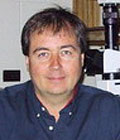
Zinin
An associate researcher in Mānoa’s Hawaiʻi Institute of Geophysics and Planetology, Zinin works in the High Pressure Minerals Physics and Materials Science Laboratory.
He was recognized for work developing a theory and conducting experimental verification for the imaging of spherical particles on the detection and imaging of sub-surface defects by acoustic microscopy. With the Humboldt fellowship, he and his collaborator developed the Fourier Optics theory for the 3-D imaging in optical and acoustic microscopes.
During an extension of the fellowship, he used high frequency acoustic microscopy to study the mechanics during cell division of cancer cells.
At Mānoa, Zinin’s research interests include materials science and metallurgy, solid state physics, solid body physics and crystallography. He is a member of the Physical Society of America, American Geological Union and Acoustical Society of America.
John M. Pezzuto, biochemistry, 1990

Pezzuto
Founding dean of the UH Hilo College of Pharmacy, Pezzuto has conducted National Institutes of Health research continuously since 1977.
His Humboldt award was used to work with Bert Wagner at the University of Munich on novel aspects of immunomodulation.
“Equally important, though, was the establishment of long-term relationships that have influenced our work and social and professional interactions for the past 20 years,” Pezzuto says.
His current research interests are predominately in the areas of biology-driven natural product drug discovery and characterization, with primary emphasis in the fields of cancer chemotherapy, cancer chemoprevention, malaria and AIDS.
Maqsudul Alam, microbiology, 1986
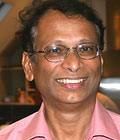
Alam
A professor of microbiology at UH Mānoa, Alam is director of advanced studies in genomics, proteomics and bioinformatics. He is interested in microbes that live in extreme environments and microbial hemoglobin/myoglobin sensors.
Since joining UH in 1992, Alam received the National Institutes of Health Shannon Award in 1997 and UH Regents’ Excellence in Research Award in 2001.
In 2004, the National Science Foundation announced his discovery of two oxygen-laden proteins in microbes that are the earliest known ancestors to hemoglobin. In addition to bringing scientists closer to identifying the earliest life forms to use oxygen, the research may aid in the search for blood substitutes as more is learned about how the subject proteins, called protoglobins, evolved to carry and release oxygen, Alam said in a news release.
Wai Fah Chen, civil engineering, 1984
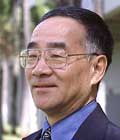
Chen
A professor in UH Mānoa’s Department of Civil and Environmental Engineering, Chen pursues research interests in structural analysis, steel and concrete design, soil mechanics, geotechnical engineering, numerical simulation and modeling of civil engineering systems, material science.
He received a Humboldt Award for his contributions to the theories of structural stability and plasticity and their application to structural design. He spent his Humboldt year on applications of theory of plasticity to structural concrete design.
Since then, he received fellowships in Hong Kong and Japan; was honored with awards, including the Hortridge Hardesty Award from the American Society of Civil Engineers and Lifetime Achievement Award from the American Institute of Steel Construction; and inducted in the U.S. National Academy of Engineering.
Chen joined UH Mānoa as dean of the College of Engineering in 1999, stepping down in 2006.
Ronald Knapp, mechanical engineering, 1981
A UH alumnus (PhD in mechanical engineering ’73), Knapp pursues structural engineering and engineering mechanics.
His research interests include solid mechanics and design; ocean structures, shells, ropes and flexible pipe; development of cable modeling software; and rehabilitation engineering.
Major publications deal with undersea cables.
M. E. “Jeff” Bitterman, psychology, 1981
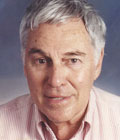
Bitterman
An emeritus professor of psychology and member of the Bekesy Laboratory of Neurobiology, Bitterman remains interested in learning and the evolution of intelligence.
It was during his Humboldt sponsored year in Germany that he discovered an ideal model for learning in invertebrates—the honeybee.
He continues to study hives introduced to Mānoa with a former graduate student who is now on faculty in psychology and at the Pacific Biosciences Research Center. See Mālamalama January 2008.
Others
Nina Azari received a Humboldt Award for her work in neurology while serving as a UH Hilo assistant professor in psychology in 1995. Suhel Parvez received Humboldt recognition in 2008 while working as a postdoctoral researcher in the John A. Burns School of Medicine.
Use the comments section to share information about other UH faculty or alumni with Humboldt ties.
Tags: astronomy, award, biochemistry, engineering, Institute for Astronomy, July10 issue, microbiology, UH Manoa

August 1st, 2010at 7:46 pm(#)
My sister, Amy Agbayani (with the S.E.E.D. office at U.H.-Manoa e-mailed me today- gave me the info so I checked out your list. I note that the list covers RECENT awardees of the prestigious A.Von Humbolt awards.
I just wanted to point out that my late husband, Stanley Starosta was also a recipient, actually 2 times, which is quite unusual.He was classified as an A.Von Humboldt Fellow, in 1979, and also in 1989. While in Germany (on leave fr. U.H. Dept. of Linguistics, during his 1st time as a Fellow , he was affiliated with the Institute Fur Deutsche Sprache.
I am writing this to you just because I wanted to let you know.
Mrs. Aleli Starosta
Widow of Dr. Stanley Starosta who passed away in 2002.
August 9th, 2010at 8:22 am(#)
Thank you for writing Mrs. Starosta. What a remarkable accomplishment. Our belated condolences on your loss.
Readers can read about this noted linguist at a memorial website.
Malamalama editor